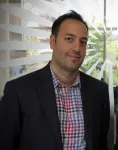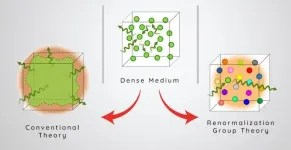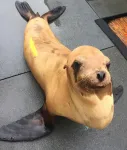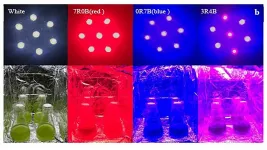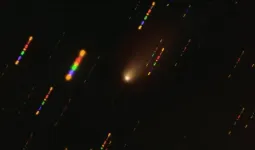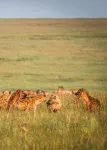Ever wondered what red foxes eat? There's a database for that
Researchers create a free, online database on global carnivore diets to help conservationists and educators
2021-03-30
(Press-News.org) Research into the diets of a large number of the world's carnivores has been made publicly available through a free, online database created by a PhD student at the University of Sussex.
From stoats in the UK to tigers in India, users are now able to search for detailed information about the diets of species in different geographical locations around the globe.
Created by doctoral student Owen Middleton, CarniDIET is an open-access database which aims to catalogue the diets of the world's carnivores by bringing together past peer-reviewed research. He hopes it will be a useful resource for conservationists and researchers, as well as educators and nature-lovers alike.
Owen said: "There is so much information out there that is useful for conservation, but much of it isn't digitized, or it may be difficult for people to access.
"Typically, anybody interested in species' diets would have to go through an extensive body of literature, but through CarniDIET, there's now an easy way to access this information with all the original references cited."
The main purpose of CarniDIET is to facilitate further conservation research by providing a place to easily access data describing the ecological requirements and ecological effects of many endangered species, which can vary across their geographic ranges.
However, there are also hopes that the tool can be more widely used by teachers, students and citizen scientists.
Owen said: "Species diets can vary massively geographically and CarniDIET is a really easy way to find out how the diet of a red fox might be different in the UK compared to China, or how the diets of lions and leopards differ.
"Users can search by a particular species or country, and simply click on an interactive map of the world to find out what carnivores eat in that area.
"It will be invaluable for younger school students learning about the food chain, or older students delving into a bit more depth about endangered species or working on geographical case studies."
Dr Chris Sandom, Senior Lecturer in Biology at the University of Sussex, added: "CarniDIET is a really exciting new tool for conservationists, researchers and educators.
"Understanding the diets of animals is hugely important for conservation; you can't protect animals in isolation, they're connected in food webs. If prey species are under threat or have dwindling numbers, it will have a knock-on effect on their predators, and leave those species threatened too.
"CarniDIET will be a useful tool to help demonstrate this by clearly showing which prey species carnivores are eating, and to an extent, are reliable on in particular geographical locations."
INFORMATION:
The tool, which will be available to use from 30 March 2021, is described in a research paper, published in Global Ecology and Biogeography. It still only covers a fraction of the available data out there and the aim is to continue developing CarniDIET by incorporating more studies and more species of carnivore. The database can be accessed at https://bit.ly/3weP1Ht.
[Attachments] See images for this press release:

ELSE PRESS RELEASES FROM THIS DATE:
2021-03-30
A simple plastic water bottle isn't so simple when it comes to the traditional manufacturing process. To appear in its final form, it has to go through a multi-step journey of synthetic procedure, casting, and molding. But what if materials scientists could tap into the same biological mechanisms that create the ridges on our fingertips or the spots on a cheetah in order to manufacture something like a water bottle?
A research paper titled END ...
2021-03-30
Preclinical research from VCU Massey Cancer Center published recently in the Proceedings of the National Academy of Sciences shows that the combination of two existing drugs can exploit the metabolic "hunger" of a particularly aggressive type of neuroblastoma to kill cancer cells without inflicting too much collateral damage to healthy tissue.
Neuroblastoma - a type of cancer that strikes the nervous system of very young children - is one of the deadliest pediatric cancers. And children whose neuroblastoma overexpresses the gene MYCN tend to have the worst prognosis.
While medical advancements have led to high cure ...
2021-03-30
LOWELL, Mass. - Too often, contends UMass Lowell faculty researcher Brenna Morse, children with complex chronic medical conditions spend days in the hospital undergoing tests for what could be a simple diagnosis.
The challenges include, she says, some children with medical complexities, such as severe neurological conditions and functional impairments, cannot easily signal that they are in pain or point where in their body it is located. Where children not facing such a challenge might be able to have a medical issue resolved with a simple visit to their primary care doctor, others end up hospitalized and going through days of costly testing to arrive at similar diagnoses.
Morse, a UMass Lowell ...
2021-03-30
Pink Floyd's Dark Side of the Moon cover, voted the greatest classical rock album of all time, intended to portray the prism and dispersion of light into a rainbow as a certain metaphorical symbolism and a light show that was never celebrated. However, they really were not aware of the fact that this image would be used by many to help illustrate the concept of refractive index and how light changes speed and direction when it encounters a different medium.
Although conceptually the drawing was not accurate, it conveyed the message that light changes its speed when it moves into another medium, and that the different speeds of different colors causes white light to disperse ...
2021-03-30
Sausalito, Calif. (March 30, 2021) - After more than three decades of research, scientists have proven that the cancer affecting up to one in four adult California sea lions necrospied at The Marine Mammal Center in Sausalito, CA, is caused by a sexually transmitted herpesvirus. The cancer, known as sea lion urogenital carcinoma, has clear parallels to cervical cancer in humans and provides a helpful model for human cancer study.
Scientists have long suspected this cancer was associated with a virus, but this is the first study to prove this theory. The study, which was published in Animals, an open-access, peer-reviewed journal, concluded that genital herpesvirus is ...
2021-03-30
WASHINGTON, March 30, 2021 -- Emerging technologies can screen for cervical cancer better than Pap smears and, if widely used, could save lives both in developing nations and parts of countries, like the United States, where access to health care may be limited.
In Biophysics Reviews, by AIP Publishing, scientists at Massachusetts General Hospital write advances in nanotechnology and computer learning are among the technologies helping develop HPV screening that take the guesswork out of the precancer tests. That could mean better screening in places that lack highly trained doctors and advanced laboratories.
Cervical cancer is the world's fourth-most common cancer, with more than ...
2021-03-30
WASHINGTON, March 30, 2021 -- As ethanol, biodiesel, and other biofuels continue to present challenges, such as competing with food security or lacking the technology for more efficient and low-cost production, microalgae are gaining momentum as a biofuel energy crop.
In their paper, published in the Journal of Renewable and Sustainable Energy, by AIP Publishing, Yangzhou University researchers in China show how a combination of monochromatic red and blue LED illumination on one type of microalga can enhance its growth and increase the biosynthesis of critical components, such ...
2021-03-30
New observations with the European Southern Observatory's Very Large Telescope (ESO's VLT) indicate that the rogue comet 2I/Borisov, which is only the second and most recently detected interstellar visitor to our Solar System, is one of the most pristine ever observed. Astronomers suspect that the comet most likely never passed close to a star, making it an undisturbed relic of the cloud of gas and dust it formed from.
2I/Borisov was discovered by amateur astronomer Gennady Borisov in August 2019 and was confirmed to have come from beyond the Solar System a few weeks ...
2021-03-30
WASHINGTON, March 30, 2021 -- Scientists are developing tools to observe the biological machinery in in vivo animal models to be able to understand and better treat severe brain diseases like Alzheimer's disease and many other conditions. Holographic endoscopes attracted researchers' interest because of their potential to conduct minimally invasive observations inside the human body.
These tools can shed light on the biological processes occurring at the macromolecular and subcellular levels, which usually remain hidden from sight as most tissue is opaque to visible radiation. In APL Photonics, by AIP Publishing, researchers from the Leibniz Institute of Photonic Technology in Germany created a particularly narrow ...
2021-03-30
It makes evolutionary sense for long-lived animals to have complex social relationships - such as friends and enemies - researchers say.
Some species and individuals focus their energy on reproduction (live fast, die young), while "slow-living" animals prioritise survival and tend to live longer lives.
In the new paper, University of Exeter scientists argue that natural selection favours complex social structures among slow-living animals - meaning that knowing their friends and enemies is easier for animals with longer lifespans, and helps them live even longer.
Meanwhile, fast-lived species should only bother with such social relationships if it increases ...
LAST 30 PRESS RELEASES:
[Press-News.org] Ever wondered what red foxes eat? There's a database for that
Researchers create a free, online database on global carnivore diets to help conservationists and educators


